How do you save pumpkin seeds from your favorite Halloween jack-o’-lantern or Thanksgiving pie? Pumpkin seed saving is not just a fun activity; it’s a smart way to preserve your favorite pumpkin varieties for future planting. Plus, it’s easier than you might think.
You’ll learn how to hand-pollinate pumpkins, choose the best pumpkins for seeds, and clean and store those seeds properly. We’ll also discuss the differences between heirloom and hybrid seeds and how to ensure your seeds remain viable for years.
Ready to become a pumpkin seed-saving expert? Let’s dive into the steps and tips that will help you grow thriving pumpkins year after year.
- Related Article: Learn About Seed Saving
6 Key Takeaways on Pumpkin Seed Saving
- Saving pumpkin seeds is a beginner-friendly way to learn about seed preservation.
- You can collect the most seeds from ripe pumpkins with firm and healthy vines.
- You can clean pumpkin seeds by floating and rinsing them so they separate from the pulp.
- Open-pollinated and heirloom pumpkin seeds will retain the exact qualities of the parent plants.
- It’s important to dry pumpkin seeds properly to prevent mold and maintain viability for seed saving. Choose a cold, dry place for storing your seeds, like an airtight container inside a refrigerator, to increase shelf life.
- Check stored seeds regularly for damage or mold. Throw away seeds that look unhealthy to maintain the quality of the bunch.
Overview Pumpkin Seeds: Why Save Them?
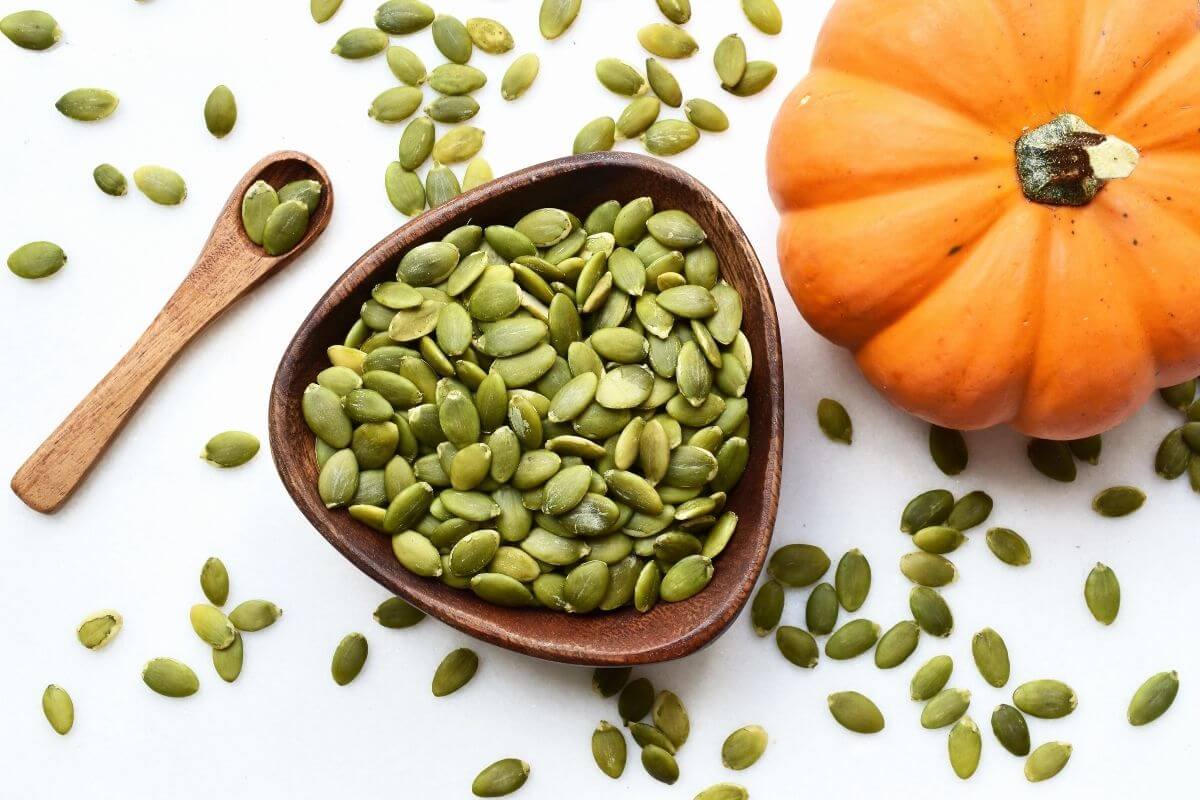
Pumpkins have male and female flowers and rely on insects for pollination. More pollinators mean better fruit.
Grow your pumpkins and ensure insects can access them or hand pollinate. Bees are the most common pollinators.
You can hand pollinate by removing petals from the male flower (the one with the large stamen and visible pollen) and gently rubbing the stamen into the center of the female flower. Then close the female flower with a rubber band.
If your pumpkin grew near other cucurbits like squash or gourds, cross-pollination can happen, leading to different fruit traits in future plants.
If you plan to grow a vegetable garden with saved seeds, another great crop to add is cucumbers. You can also preserve cucumber seeds, making them a great addition to your garden alongside pumpkins.
How to Save Pumpkin Seeds
Looking to save your pumpkin seeds? There’s nothing to it — just follow these steps:
Step 1 – Harvest the Best Pumpkins for Their Seeds
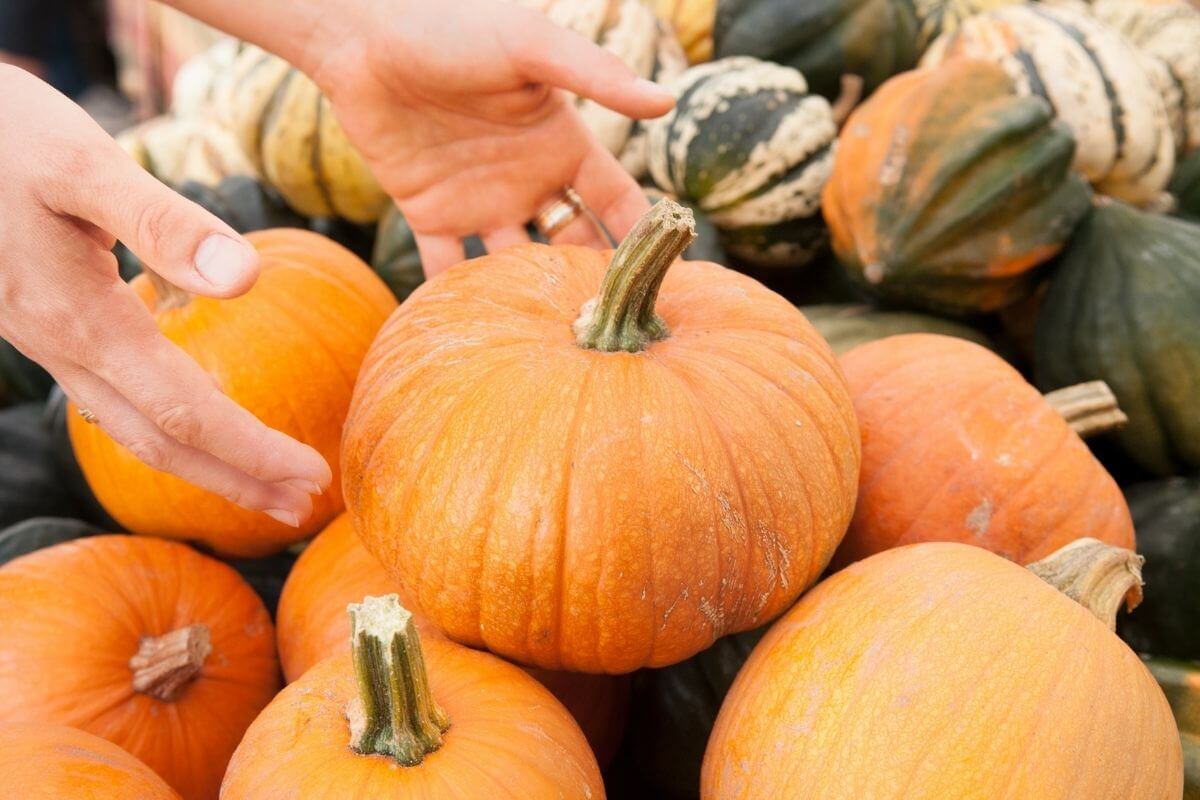
To save pumpkin seeds well, start by picking the best pumpkins for seeds.
Choose heirloom or open-pollinated types instead of hybrids. This ensures the seeds will grow well in the future. Look for ripe pumpkins with firm skin and drying vines because these show the seeds inside are ready.
Check pumpkins for disease, spots, or rot as these can harm the seeds. Larger pumpkins usually have more seeds. But avoid old ones that might crack. Pick pumpkins with strong stems because they are healthier and have better seeds.
Step 2 – Clean Pumpkin Seeds
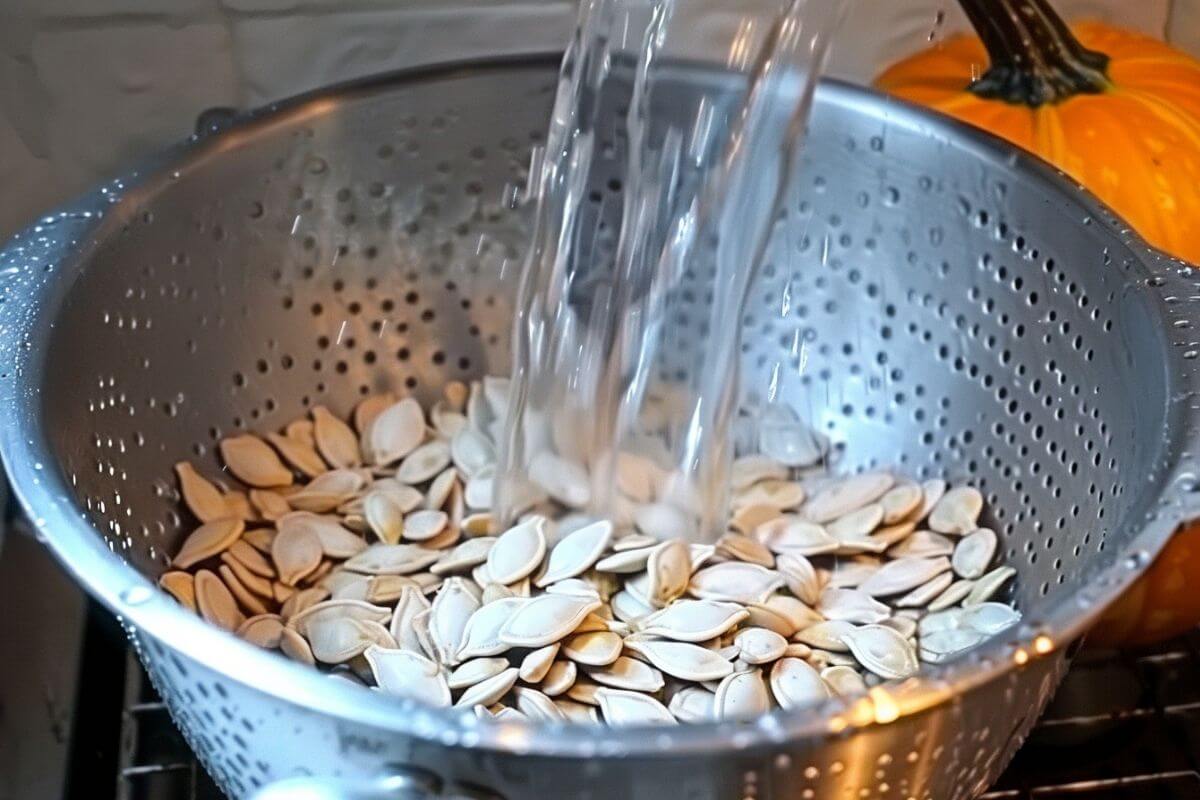
When you’ve decided on a favorite pumpkin you want to save seeds from, open it up. You can then harvest and clean the seeds of your chosen pumpkin using this step-by-step guide:
- Remove Seeds and Pulp – Cut open the pumpkin and scoop out the seeds and surrounding pulp into a large bowl. Fill the bowl with water and gently stir. The seeds will float to the top while the pulp sinks to the bottom, making separation easy.
- Rinse Seeds in Colander – Transfer the seeds to a colander and rinse them under cool water. Use your fingers to remove any remaining pulp and slime, making sure that you have clean seeds.
- Optional Soaking for Extra Cleanliness – If desired, soak the seeds in hot water for a few minutes. Swish them around to loosen any stubborn pulp. For a salty flavor, soak them in salted water (2 cups water with 1 tablespoon salt).
- Final Rinse – After soaking, rinse the seeds once more under clean water to remove any leftover pulp and salt.
Step 3 – Choose the Pumpkin Seeds to Save
After cleaning your pumpkin seeds, pick the largest and fullest ones. This increases your chances of growing strong plants. Make sure the seeds are mature and firm with a consistent color. Save about three times more seeds than you need. This way, you can cover any that don’t sprout and pick the healthiest seedlings.
Check each seed carefully. Discard any that look damaged, discolored, or moldy. Keep only the healthy and whole ones. Remember, seeds from heirloom types will grow plants just like the parent plant. Seeds from hybrids may not be the same.
After harvesting, use a process called fermentation to separate the seeds. Good seeds will sink in water. Bad ones and pulp will float. Choose the sinking seeds for the best chance of growing healthy plants. These steps will help you grow thriving pumpkins from your seeds.
Step 4 – Dry the Pumpkin Seeds
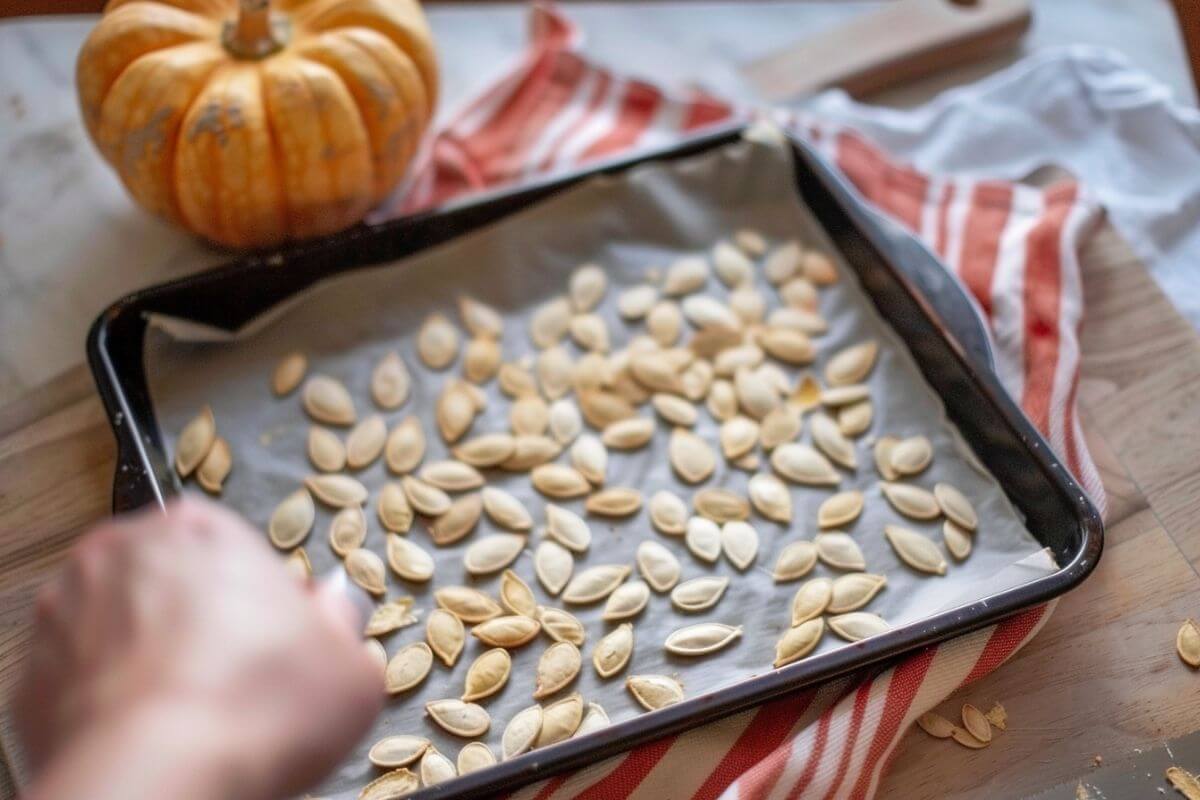
To dry pumpkin seeds, start by spreading cleaned seeds in a single layer on wax paper. Let them dry overnight so they don’t stick. Then, transfer the seeds to a paper towel or clean dish towel and spread them out evenly.
Place them in a cool, dry area away from direct sunlight for 5-7 days. Turn or stir them daily to ensure even drying.
Once the seeds are partially dry, move them to a paper towel-lined baking sheet. Spread them out in a single layer and place the sheet in a cool, dark place with good air circulation.
Let the seeds dry undisturbed for at least one month. Check them daily to prevent mold formation.
To see if the seeds are ready, feel them. They should be crisp and break rather than bend. Avoid washing the seeds before drying to maintain their quality for future planting or eating.
Step 5 – Store the Pumpkin Seeds Properly
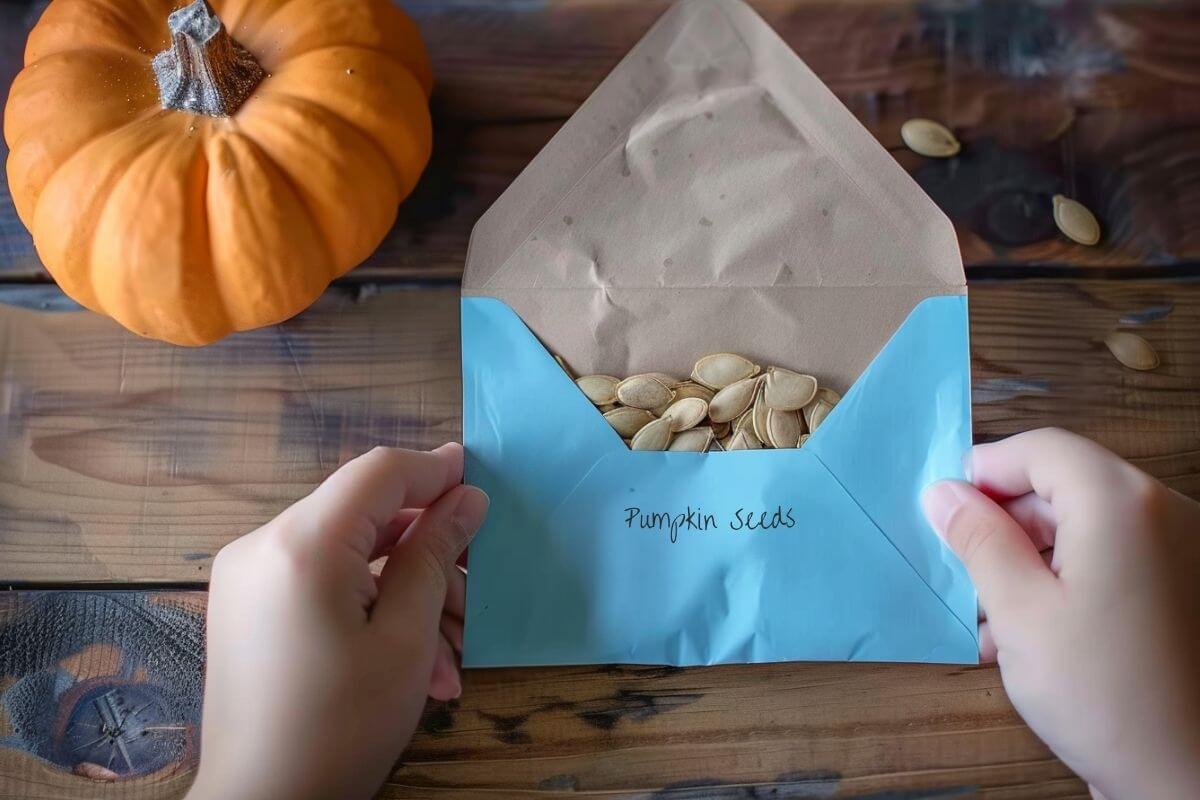
Once your pumpkin seeds are dry, store them in a paper envelope or small paper bag. Write down the harvest date and type of pumpkin on the envelope. This helps you remember when you collected them and what kind they are.
Keep the seed envelope in a cool, dry place. The fridge is a good spot because it stays cool and helps keep the seeds viable.
To prevent moisture, put the seed envelope in a plastic container with holes in the lid. This allows air to flow in while keeping the seeds from getting too damp. You can also store the seed envelopes in an airtight container in the fridge.
If you can’t use the fridge, find a cool, dark place where the temperature doesn’t change much. Avoid plastic bags because they can collect moisture and harm the seeds over time.
Check the stored seeds regularly for mold or damage. Discard any that don’t look healthy.
How Long Will My Pumpkin Seeds Last?
Pumpkin seeds can stay good for planting for 3-4 years if stored right. But they lose about 10% of their viability each year, even when stored well (source).
To keep your seeds viable and ensure they germinate, dry them for about a month after harvesting. Store them in a cool, dark, dry place like a refrigerator. Use an airtight container to keep out moisture and pests. Try a floatation test to check if the seeds are good: discard the ones that float and plant the ones that sink.
Even with good storage, germination rates drop over time. For best results, use your pumpkin seeds within 1-2 years of harvesting. They can last up to 4 years if conditions are perfect.
Can I Have and Grow Hybrid Pumpkin Seeds?
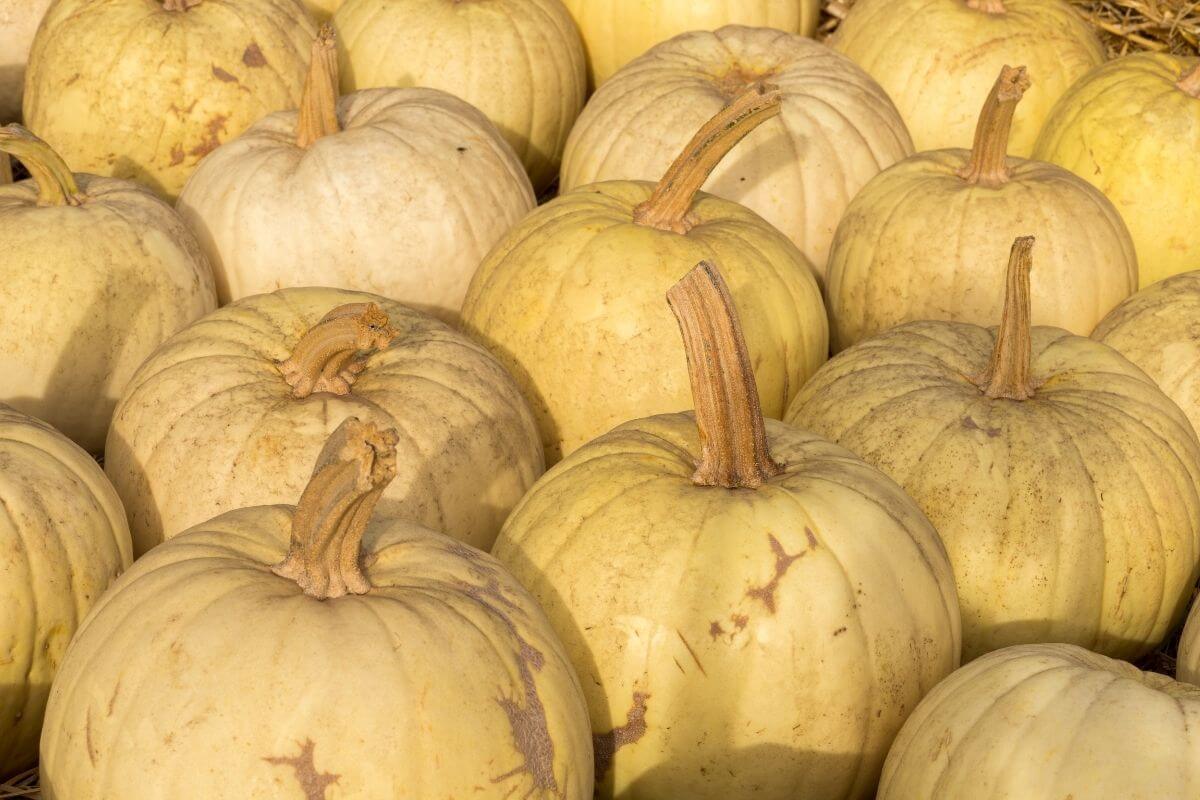
Hybrid pumpkin seeds have a high success rate in germination and growth. They are similar to other pumpkin varieties if you give them proper care and conditions. Varieties like Autumn Gold offer benefits like disease resistance, uniform size, and higher yields. But heirloom pumpkins have unique traits and let you save seeds, which some people love.
You can buy hybrid pumpkin seeds from trusted suppliers. Rupp Seeds sells varieties like Hybrid Pam. Harris Seeds offers Prizewinner F1. You can also find them on Amazon, where Autumn Gold Hybrid is popular.
To grow hybrid pumpkins, plant seeds ½” to 1″ deep. Adjust the spacing based on the fruit size. Give them consistent care throughout the growing season.
Final Thoughts on Pumpkin Seed Saving
Saving pumpkin seeds is a rewarding hobby. It saves you money and makes you a better gardener. Plus, you get delicious pumpkins every year.
You will learn to spot issues and pests early. This helps you grow better pumpkins each time.
Open-pollinated and heirloom pumpkin seeds are easier to find now. There’s more interest because people are pushing back against GMOs. For years, gardeners avoided saving seeds because they only had access to F1 hybrids. This forced them to buy new seeds every year.
The internet has helped gardeners get open-pollinated seeds. Most businesses want you to keep buying seeds. But if you buy a bag of open-pollinated pumpkin seeds, you might never need to buy seeds again.
Pumpkin Seed Saving FAQs
1. Can I Save Seeds From Store-Bought Pumpkins?
Yes, you can save seeds from store-bought pumpkins. Ensure they are fully ripe and follow the same cleaning and drying process outlined for home-grown pumpkins.
2. How Do I Know if Pumpkin Seeds Are Viable for Planting?
Conduct a floatation test: place seeds in water and discard any that float, as they are less likely to sprout. Sinking seeds are typically viable.
3. Can Pumpkins Cross-Pollinate With Other Squash?
Yes, pumpkins can cross-pollinate with other squash varieties if grown nearby, potentially affecting the characteristics of future fruits.
For other guides on how to save seeds:


